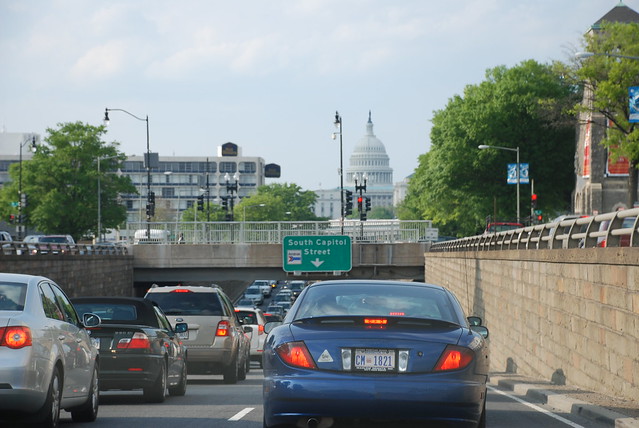Photo (cc) Joe Shlabotnik
The Transport Politic: As the U.S. Presidential Election Begins in Earnest, a Study in Contrasts
What is obvious is that Mr. Ryan has a dramatically different view of the role of government than President Obama; indeed, his perspective on that which Washington should be concerned is a deep expression of the conservative movement’s success in pushing the GOP to the right.
In matters of transportation, this attitude would steadily decrease the role of the federal government in sponsoring infrastructure projects, especially those that cannot be sponsored entirely through user fees. It would discourage the consideration of negative externalities, such as pollution and congestion, in deciding what subsidies should be provided for alternative transportation — because its political ideology opposes government subsidies altogether. It would dismantle enforcement of federal environmental regulations, especially those that recognise climate change, and encourage the privatization of public services such as transit systems or parking meters. These are the very tangible implications of a Romney-Ryan presidency.
The Wall Street Journal: Streetcar Plans Plow Ahead
Proponents say the streetcars would boost economic growth and catch the fancy of younger generations.
“Kansas City’s downtown has bled jobs, people and buildings for decades,” said David Johnson, a 38-year-old engineer and co-founder of Streetcar Neighbors, a residents group that advocates for streetcars in that city. “We’re trying to reinvigorate the downtown.”
But others see a waste of tax dollars on projects that, they say, offer little more than a way to move downtown workers from their offices to lunch.
Warwick Beacon: Study finds RI severe storms increase by 90%; global warming to blame
A new report by Environment Rhode Island says the frequency of extreme weather, like snowstorms and downpours, is almost double what it was in 1948.
The data comes from a study that analyzed roughly 80 million daily precipitation records from across the United States. Those from Environment RI identified the single most extreme weather event (storms with the most precipitation in 24 hours) in each of the 64 years they studied, and analyzed the trends over the various regions of the U.S.
The trends show that New England, specifically, is experiencing an increase in extreme weather. The Northeast region experienced an 85 percent increase in rainstorms and snowstorms since 1948.
The New York Times: Frustrations of Air Travel Push Passengers to Amtrak
Long a punch line for harried Northeast travelers, Amtrak has come to dominate commercial travel in the corridor connecting Washington, New York and Boston, and this summer its trains are packed.
A decade ago, Delta and US Airways shuttles were the preferred mode of travel between the cities. But high fares, slow airport security and frequent flight delays — along with Amtrak’s high-speed Acela trains, online ticketing and workstation amenities — have eaten away at the airlines’ share of passengers.
Smart Growth America: Don’t call it a comeback: the rebirth of downtown Roanoke, VA
“Ten years ago, 11 people lived in downtown Roanoke,” says City Manager Chris Morrill. “Now 1,200 do. Even two and a half years ago, people were talking about what Roanoke wasn’t, what it could have been if it had something else. Now people are taking pride in their communities, getting out more, making connections to downtown, going out to the farmer’s markets, and they love the greenways. There’s a definite sense of optimism, that we’re going in the right direction and creating the type of place where people want to live.”






Time Lapse
The Journal’s Time Lapse Blog has been a good series. It amazes me how much of the city has been destroyed. I’m not sure that I agree with the statement that Providence mostly escaped urban renewal. The Furlong Apartments probably had people of color living in it, which is likely why they raised it. That Benefit area north of the old state house was a mostly black neighborhood and the heart of it was Lippitt Hill where University Heights is today. I don’t remember this building specifically or the Lippitt Hill neighborhood, but I do remember North Main and Canal being crammed with loft buildings, as well as Randall Square with mills. When I was five or six the University Heights area were empty fields with a monoculture of hay like grass. Now we have the 195 land in a similar condition, where the initial destruction was a result of 1950s thinking. The city received a series of strategic amputations in the 50s and 60s. The downtown tentacles that extended into adjacent neighborhoods had to be contained and neutered.
http://blogs.providencejournal.com/arts-entertainment/lifestyles/time-lapse/2012/08/this-old-house-sidestepped-a-chunk-of-history.html
Comparing the photos, the house that was moved to the corner of North Court and North Main had to have been moved to make way for a parking lot. So that means that the five-story Furlong Apartment building was sacrificed so an older house could be saved and have off-street parking. How many of the city’s buildings have been demo’d for parking lots? This is not just a downtown problem and it’s still happening and in most neighborhoods.